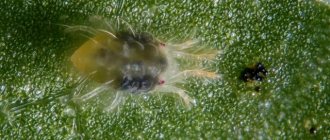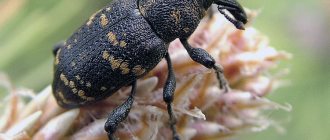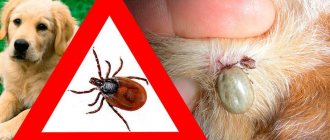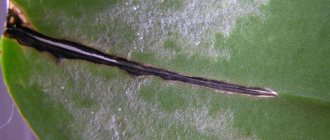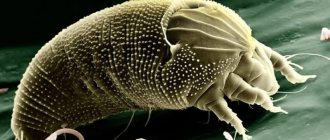Types of insects with descriptions and photos
The following types of mites can attack orchids::
- Root. This is a small spider, which is characterized by the presence of 3 pairs of legs, mustaches and a relatively large oval body. The pest is hardy, so it can remain without food for a long time. The main food is plant residues and underground parts of plants.
- False arachnoid. Pest. whose body grows only 0.3 mm in length. The body can take on different shades - from red to greenish. This variety does not entwine the plant with a web, so it can only be noticed after the appearance of a whole colony.
- Red spider mite. The danger of this parasite lies in the fact that most drugs act on it, so the pest is able to remain on the surface of the plant for a long time. The body may be red, yellow or orange.
- Bulbous. This species is small and moves slowly. The length of the bulb mite reaches 0.6 mm. The color of the pest is brown, the jaws are the same color. Spherical limbs.
- Flat-bodied. One of the smallest parasites, the length of its body does not exceed 0.3 mm. The body is oval in shape, the body is flattened, the color is yellow-red. There are many short bristles on the body.
- Armored. Representatives of spider mites. They live in soil and soil; the main source of nutrition is dead parts of the orchid.
Root mite:
False arachnoid:
Red spider:
Bulbous:
Flat-bodied:
Armored:
Signs of a tick. Why is he dangerous?
Ticks have an oval shape and 4 pairs of legs (entomologists classify them as arthropods). The color can be black, reddish-brown, whitish and yellow - depending on the species. And, it would seem, they should stand out clearly on the plant, but that was not the case. The fact is that parasites are microscopic in size (length no more than 1.1 mm), so it is quite difficult to see them with the naked eye.
However, there are a number of signs by which the pest can be identified. Here are the external signs of a tick:
- The presence of small gray or whitish inclusions on the foliage (visually reminiscent of injection marks).
- The appearance of silvery cobwebs on the back of the leaves.
- Brown spots on leaf blades (most often found at the base of the stem or in the axils of the leaves).
- Drying and deformation of foliage at the edges.
- The leaves turn yellow, curl into a tube, and then completely fall off.
- Small areas of rot may be found at the base of the plant (usually the lower part of the stem). They look like wet dark spots.
- Shortened peduncles, which is not typical for orchids.
Ticks eat the juicy pulp of the leaves, simultaneously injecting poison into the plant cells . What happens next is:
- Toxic substances dissolve cell membranes and the flower secretes liquid (a delicacy for arthropods).
- The parasite sucks out the sap, and air penetrates into the leaf cells. Therefore, the foliage takes on a whitish tint and becomes dull. This starts an irreversible process that leads to gradual death.
- The leaves turn yellow, dry out and fall off en masse. The plant dies.
An orchid is most often affected by a spider mite (can be red, green or white), but there are also other species - root (light yellow, feeds on the root system of the plant), oribatid, etc. The latter, unlike spider mites, eats the flower from the very tops of leaves.
Important! The tick reproduces in geometric progression (by laying many tiny eggs). As a result, the immune system is weakened and the plant becomes susceptible to viruses, fungi and pathogenic bacteria.
What should I use to get rid of it?
How to deal with cobwebs?
Having discovered a spider mite on an orchid, you can begin to fight it in the following ways:
- Biological. It is enough to have several walls of predatory beetles or mites - they will help the grower get rid of small mites.
- Chemical. Insecticides are used. Moreover, the drugs need to be alternated, since the parasite develops immunity to insecticides.
- People's At the initial stage of spider mite development, you can use a decoction of cyclamen. Boil the roots for half an hour, leave for 24 hours. After this, pour the solution into a spray bottle and spray the orchid for 4-5 days, 3-4 times a day.
Bulbous
When a bulbous type of parasite appears, you must immediately change the soil in the flowerpot and disinfect the container. You can completely get rid of the bulb mite in the following ways:
- Folk. This method can be used only in the early stages of the appearance of the bulb mite. The best option is a solution of laundry soap (dilute 20 g of soap in a liter of warm water). Wipe the green surfaces of the flower with the finished mixture or immerse it completely in soapy water for 30-40 minutes.
- Chemical. In this case, broad-spectrum insecticides are used. However, you can also use narrowly targeted drugs that fight ticks specifically - acaricides. The cooking method is indicated on the package. The concentration can be made less, but in no case stronger, since the product can destroy the plant.
Reference! The biological option for controlling bulb mites is not suitable in this case.
Kornev
This type of tick is very difficult and takes a long time to remove. In addition, root pests are characterized by their ability to reproduce rapidly. As soon as you notice this pest on the surface of the plant, all affected parts must be removed immediately. Don't forget to treat the cut areas with activated carbon. Affected crops must be isolated from other healthy ones.
In addition, the following methods are used to combat root mites:
- People's A decoction of nettle will do (take 700 g of dry herb for 5 liters of water and leave it in a dark place all day). The orchid is sprayed with the product 4-5 times a week. The decoction will not only help get rid of pests, but also increase the protective functions of the plant.
- Chemical. Acaricides remain an option for controlling root mites. In addition, insectoacaricidal agents, for example, Acaritox, are a good way to combat pests. Use it strictly according to the instructions described at intervals of a week. Also effective drugs are the following: Verticillin, Nematofagin and Dachnik.
- Biological. Natural oils are suitable.
Flathead
This type of parasite is difficult to destroy, so it is best to start fighting them with chemicals. You need to choose acaricides, since insecticides will be ineffective in this case. Suitable chemicals:
- Actofik;
- Fitoverm;
- Vermitek.
In addition, you can use folk remedies, for example, soap solution. Rubbing the leaf plates with alcohol also helps.
Attention! Biological agents will not help in destroying the flatworm.
Armored
This pest reproduces in the soil, so you need to start fighting it immediately after detection. First of all, the orchid is taken out of the pot and soaked in water at room temperature for 30 minutes.
In a few minutes it will be noticeable how the parasites emerge. After 30 minutes, the plant must be removed from the water and dried. To obtain maximum effect, it is recommended to carry out 2-3 procedures.
The best chemicals are:
- Aktellik;
- Karbofos;
- as well as Sumiton.
In addition, you can buy predatory mites in the store , which will help get rid of parasites.
One package will be enough for this.
Types of mites on an orchid
Varieties of mites on an orchid are represented in significant numbers. It is worth knowing that all these animals are very small: their body size rarely exceeds three millimeters. More often, their length is in the range from 0.5 to 1 millimeter, and this makes pests almost invisible to the human eye. A distinctive feature of the tick is its body, which is divided (unevenly) in two. It is by this feature that the pest can be distinguished from other insects. The tick also has twelve appendages, eight of which are legs. It is important to understand what the pest looks like in order to distinguish it and correctly understand what to do in such a situation.
The main types of mites that attack orchids include the following:
- Armored. This is an arachnid-type parasite that primarily lives in the ground. The main diet is dead flower parts.
- False (also called white cobweb due to the formation of a white web). This is one of the smallest parasites, because its size does not exceed 0.25-0.3 millimeters. It is almost impossible for a person to see this pest. Its existence on an orchid can be determined by the presence of cobwebs. In serious cases, the pests form a colony of many false spider mites, the hue of which can range from green to red.
- Flat-bodied. This is a fairly small parasite with a body length of up to 0.3 millimeters. The body itself has an oval and slightly flattened shape. The pest is yellow-red in color and has small bristles on its body. A person cannot determine the presence of single individuals due to the tiny size of the pest, so the presence must be judged by the affected areas or after the formation of a colony.
- Root. He looks like a little spider. The bug has three pairs of legs, sharp antennae and a fairly large oval body. A special feature of the tick is its increased endurance, thanks to which it can easily survive without food even for a long time. The main diet of the root mite is organic residues and underground parts of the plant.
- Red spider. This is one of the most dangerous parasites, since it does not die when the plant is treated with special pest control agents. Distinctive features of the tick are the red, orange or yellow color of the body.
- Bulbous. The parasite is quite small - no more than 0.3-0.6 millimeters. The pest has a brown tint, rich brown jaws and spherical limbs.
Note! Sometimes powdery mildew may appear on the orchid. This is a fungal type disease. Outwardly, it manifests itself in the appearance of white affected areas, which is very reminiscent of tick infestation. This is why many believe that this is due to a mealy mite attack. In reality, there is no such parasite, but the cause is a fungal disease (see photo).
Remember that all types of orchids (phalaenopsis, vanda, cymbidium, dendrobium, etc.) are susceptible to mite damage. When pests are detected, it is important to know what and how exactly the plant needs to be treated. Below we will look at methods that can be used to combat mites, which primarily affect leaves, flowers and buds, and less often the root system. Remember that in most cases the plant can be cured.
What do the affected areas look like? Pay attention to the photo, which shows one of the options. Often, damage appears on the plant in the leaf area, looking like pale yellow spots. At the same time, the edges of the leaves are very dry. As a result, if no action is taken, a fungus develops and the affected area changes its color to black. Over time, depressions and holes form. If you notice black spots on the leaves of an orchid, most likely it will not be possible to save it. That is why you need to start fighting the pest as quickly as possible.
Prevention of infection
To protect orchids from mite attacks, you should adhere to the following recommendations:
- Periodically dry the soil in which the crop grows.
- Spray the orchid regularly and make sure that water does not get into the sinuses. Otherwise, the flower will begin to rot.
- Follow the watering schedule. Do not moisten the soil until the top 4-5 cm has dried.
- Maintain optimal air humidity. Remember that ticks appear in rooms with dry air. The easiest way to increase air humidity is to place a container of water near the crop. It is enough for the container to stand near the crop for half an hour a day. This is enough for the water to evaporate and humidify the air.
Controlling mites on an orchid is very difficult. Reanimating a plant after a pest attack will be very problematic. Therefore, try to carry out preventive measures to save the culture.
If you find an error, please select a piece of text and press Ctrl+Enter.
Prevention measures
Of course, prevention does not guarantee complete protection for flowers, but it will help reduce the risk of infection to a minimum. Proper care and regular inspections are required. Purchase substrates only at specialized points. When purchasing a new plant, do not rush to place it next to the others, leave it in a separate place for a while, if during this period there are no visible reasons for concern, you can place it with the rest of the flowers.
It is advisable to carry out disinfection once a week; to do this, wipe the leaves with any disinfectant composition. Watch the soil, it should not be very wet and very dry. Ensure proper watering, get rid of excess moisture on the inflorescences, and also spray the flower.
Remember that the above types of parasites are not the only pests that attack orchids. An armored mite may appear on them, which resembles a blood-sucking parasite, only of microscopic size, or a mealy mite, which looks like a hairy louse, also of small size, and other species.
To fight them and treat the plant, various specialized drugs are needed and you need to know exactly which pest attacked the orchid.
Source
How to save a blooming orchid from spider mites
The damage caused to a flowering epiphyte depends directly on how quickly the problem is discovered. If mites were noticed at an early stage of spread, they can be managed by wiping the plant with a soapy solution or washing it in a hot shower.
If the initial stage of disease development is missed, treatment is carried out with chemicals. Then all the buds will inevitably die. It is fortunate if the infection occurred at the final stage of flowering. Otherwise, you have to stop this period at the very beginning.
If a white cobweb is found on a blooming orchid, the following work is carried out to save the flower:
- The diseased flower is transferred to a separate room away from other plants.
- All damaged flowers, buds, leaves and bulbs are cut off.
- The leaf axils and trunk are cleaned of parasites with tweezers.
- Young shoots are not completely cut off. They are cleaned of parasites from above and damaged parts are removed.
- The root system is freed from the substrate and rotten or dried areas are removed.
- The plant is completely washed with a solution of laundry soap and then treated with insecticides.
- Dry the orchid thoroughly and replant it in a dried substrate.
Use of chemicals
Using insecticides is the best way to control mites.
It is necessary to treat indoor orchids after preliminary preparation:
- clearly visible lesions are trimmed;
- the cut areas are sprinkled with crushed activated carbon or cinnamon powder;
- the substrate from the pot is disposed of;
- the pot container is disinfected with a highly concentrated solution of potassium permanganate.
To avoid pests becoming accustomed to any active substance, the drugs should be alternated.
The treated orchid is planted in a new substrate and isolated from other plants for 2-3 weeks or until the insect is completely destroyed.
Fitoverm
Biological insecticide of the contact-intestinal spectrum, based on the activity of soil fungi that are destructive to some types of pests.
The main active substance is aversecticin-C, which has paralytic properties. Penetrates through the skin and gastrointestinal tract. Detrimental to adults, but not effective against larvae and oviposition.
Suitable for spraying on vegetative mass and immersing roots. It is necessary to carry out 3-5 treatments at weekly intervals. If there is no result after the second procedure, Fitoverm is replaced with a stronger drug.
Aktellik
Organophosphorus complex of contact-intestinal action.
It is highly toxic, belongs to class 2 of hazardous toxic chemicals, can be used outdoors or with mandatory room ventilation.
The main active substance is pirimiphos-methyl. The systemic drug is able to combat different types of pests. It has a detrimental effect on adults, but is ineffective against eggs and larvae. It is distinguished by its relative speed, leading to positive results after the first treatment after 1 week.
Maintains effectiveness within 15-25°C. Apply up to 5 times with an interval of 7-10 days.
Neoron
A strong contact insectoacaricide that causes instant death of pests. The main active substance is bromopropylate.
It has long-lasting activity, providing reliable protection for 30-40 days at any temperature. Does not penetrate plant tissue, acts superficially.
Suitable for use against adult insects, larvae and oviposition. There is no resistance. Toxic. If the affected area is small, the concentration must be reduced.
Thiophos
After treatment, the plant must be replanted
An oil-based organophosphorus insecticide with a garlicky odor that repels ticks. The main active ingredient is parathion.
Apply once in case of extensive infection, because highly toxic. Used primarily on an industrial scale.
Features of orchid damage by armored mites
The orchid mite is easy to notice: on the smooth surface of the leaves of the plant, small black insects moving around are visible to the naked eye. A large number of these pests on the plant indicates that the soil is too moist, which is why the bark, moss and forest litter in the pot begin to rot. Such damp conditions are favorable for the development of oribatid mites. You can see the parasites on the roots of the orchid in the photo.
Armored mites occur during a period of actively multiplying pathogenic microflora; all these bacteria and fungi can kill an orchid in just a couple of days.

